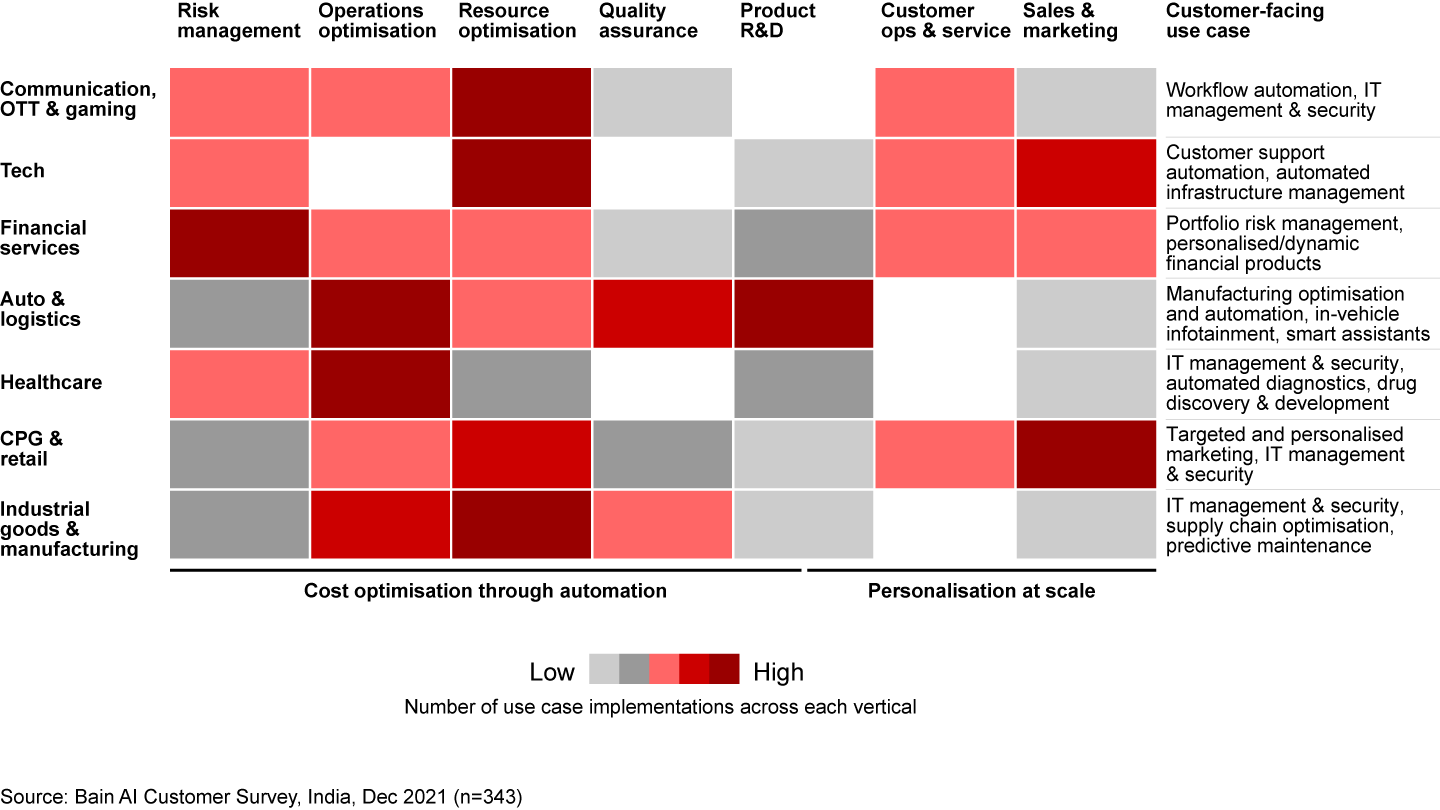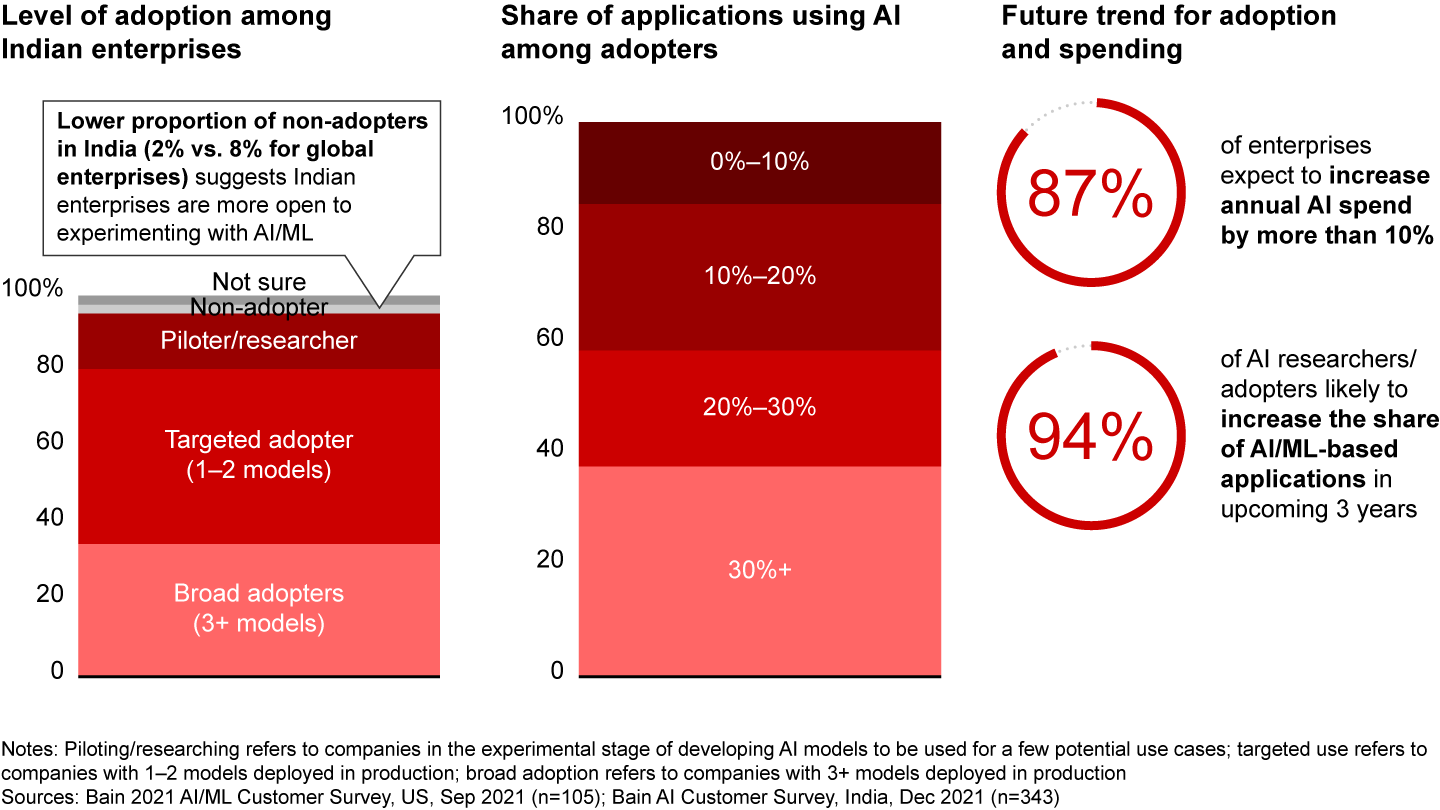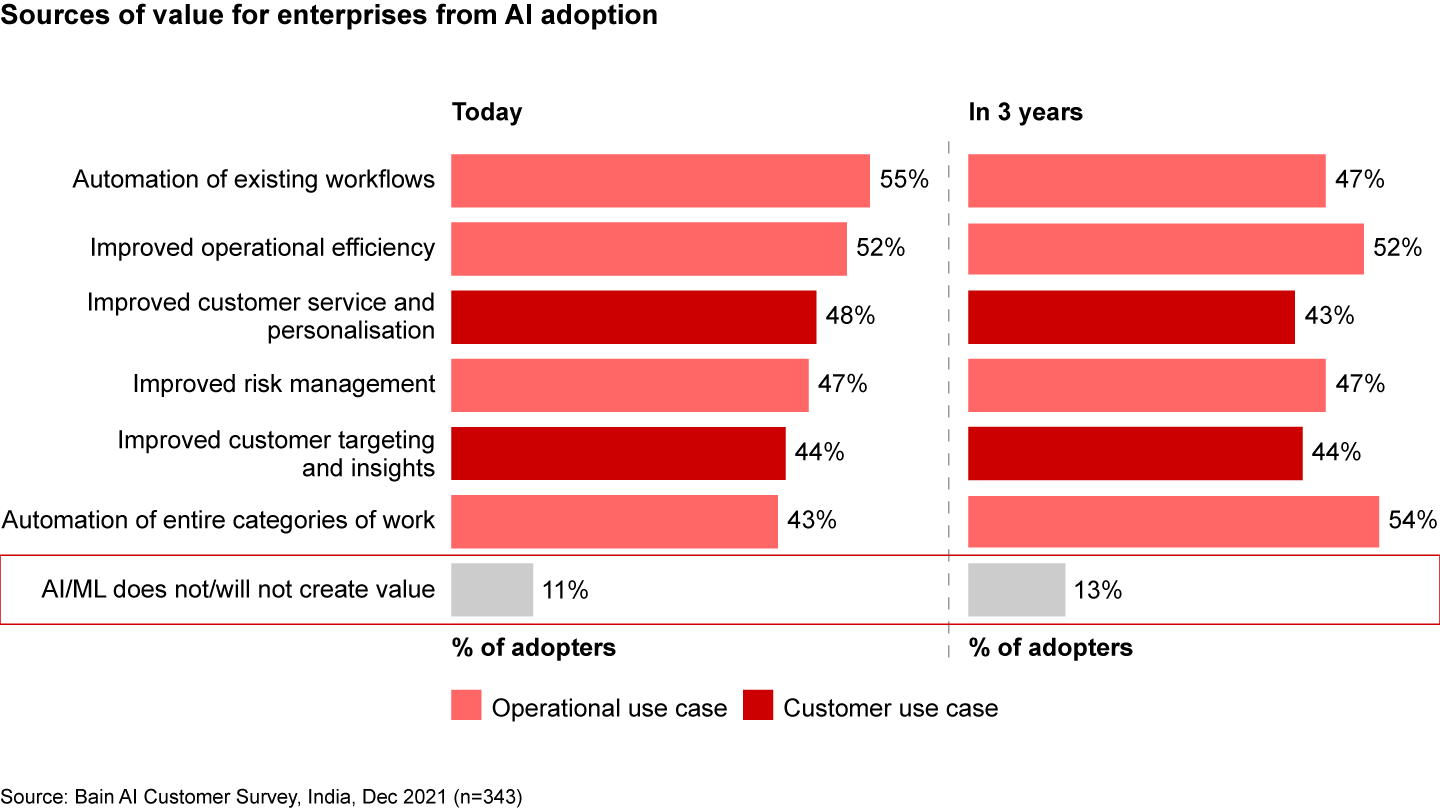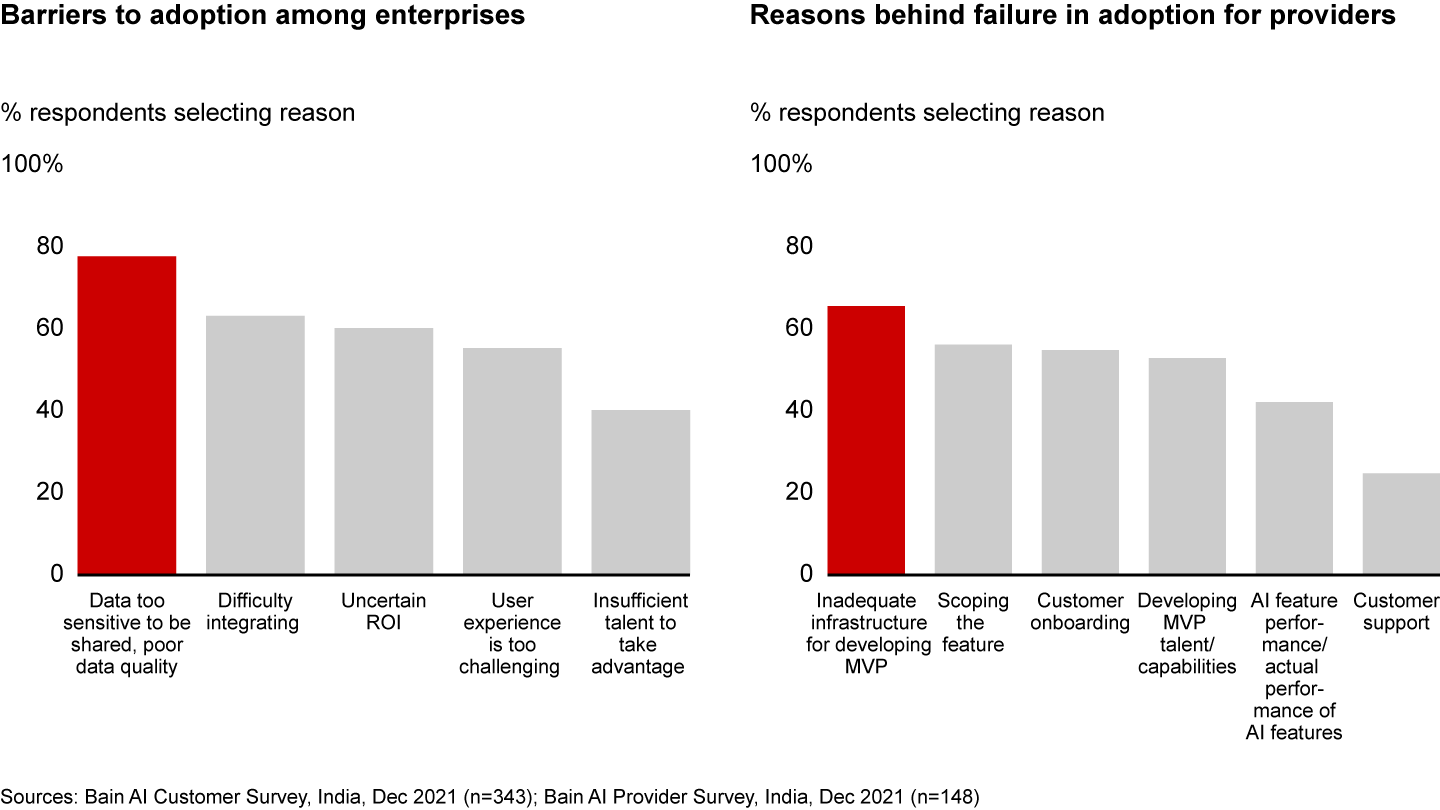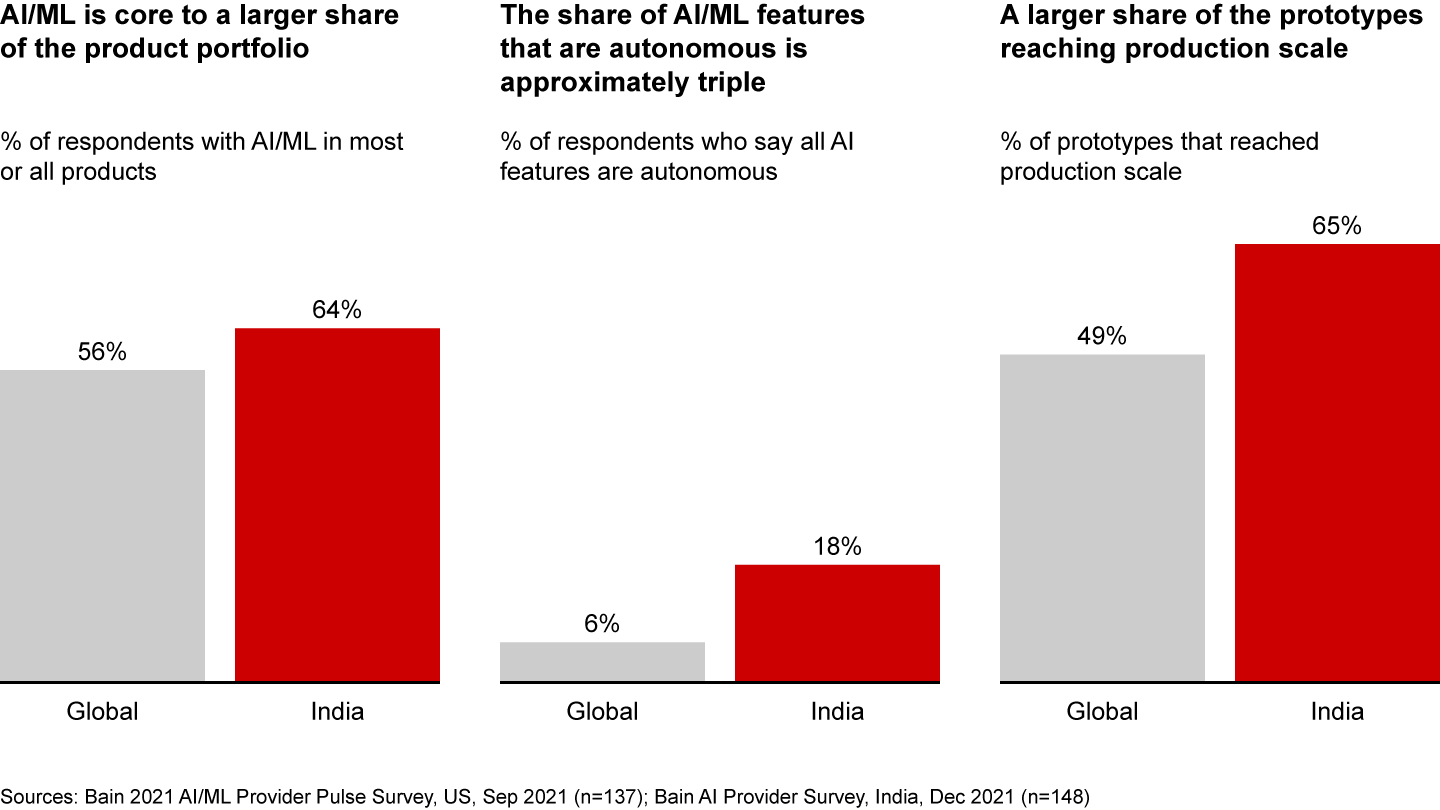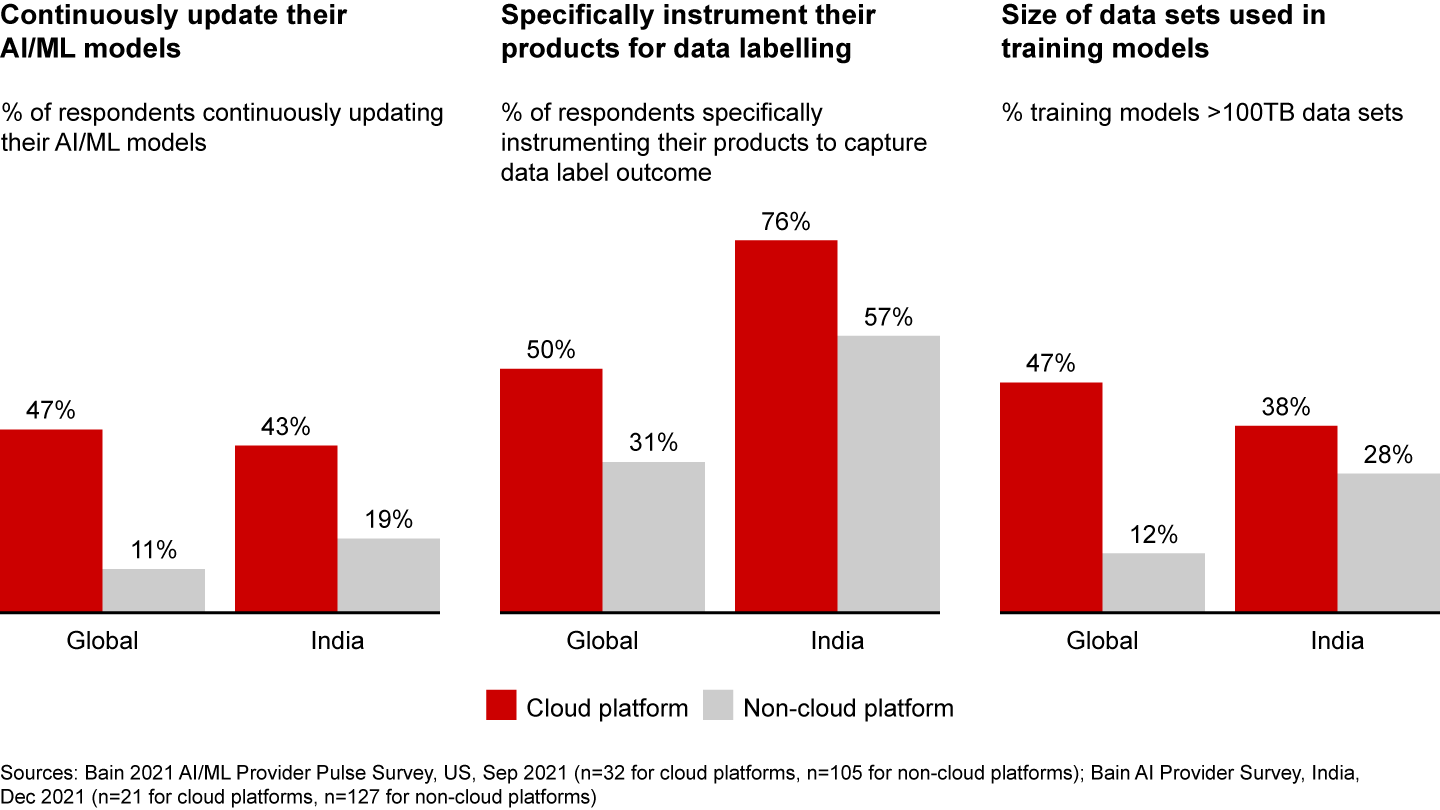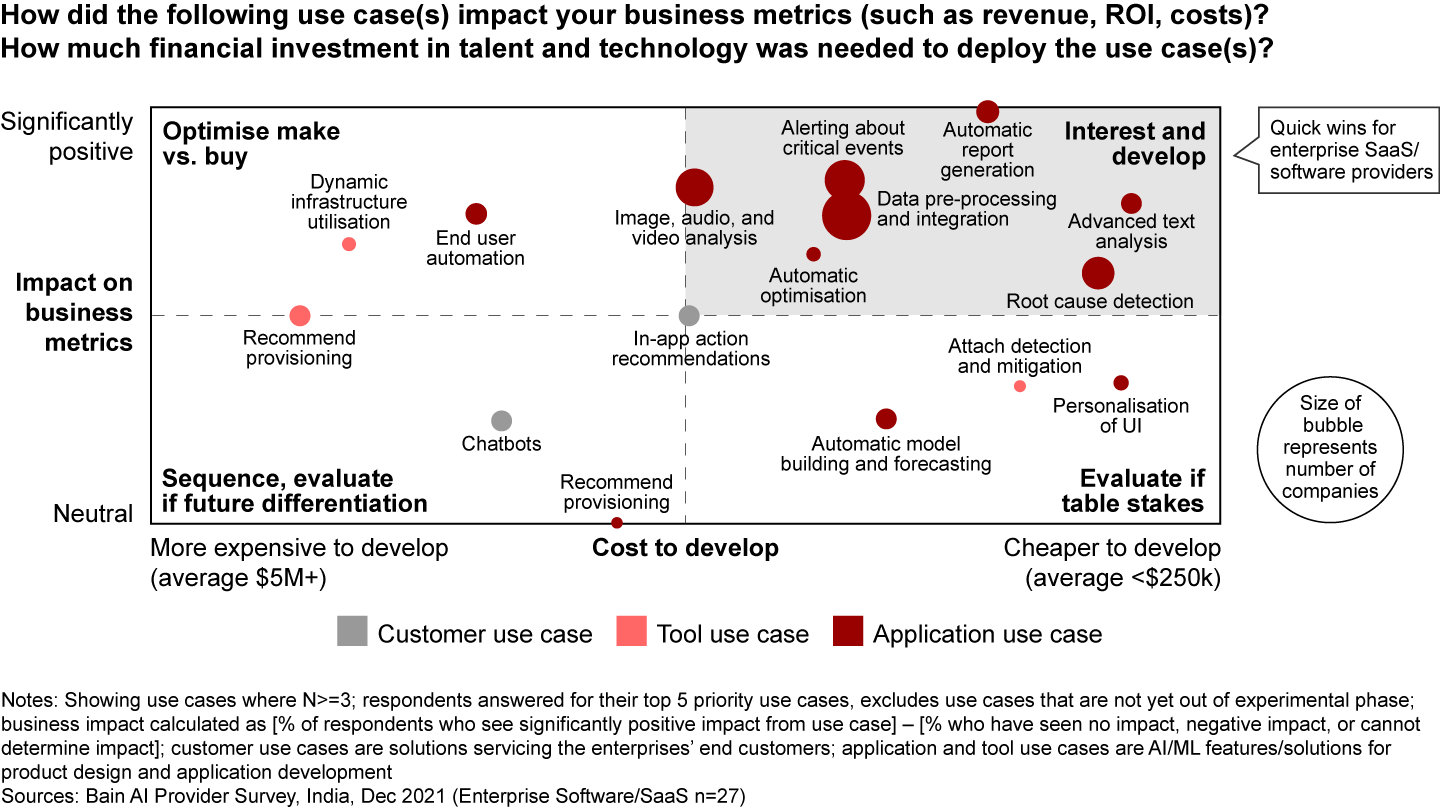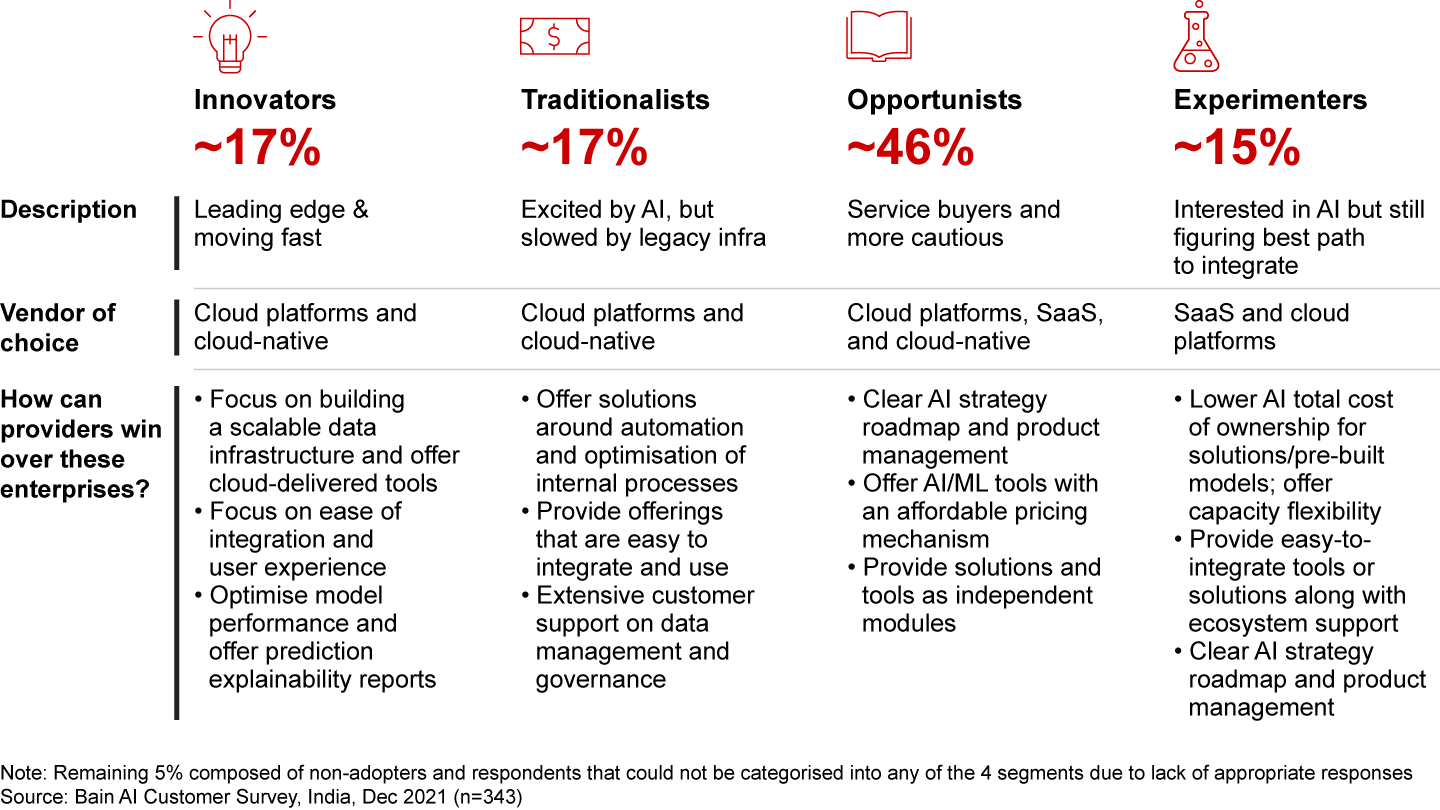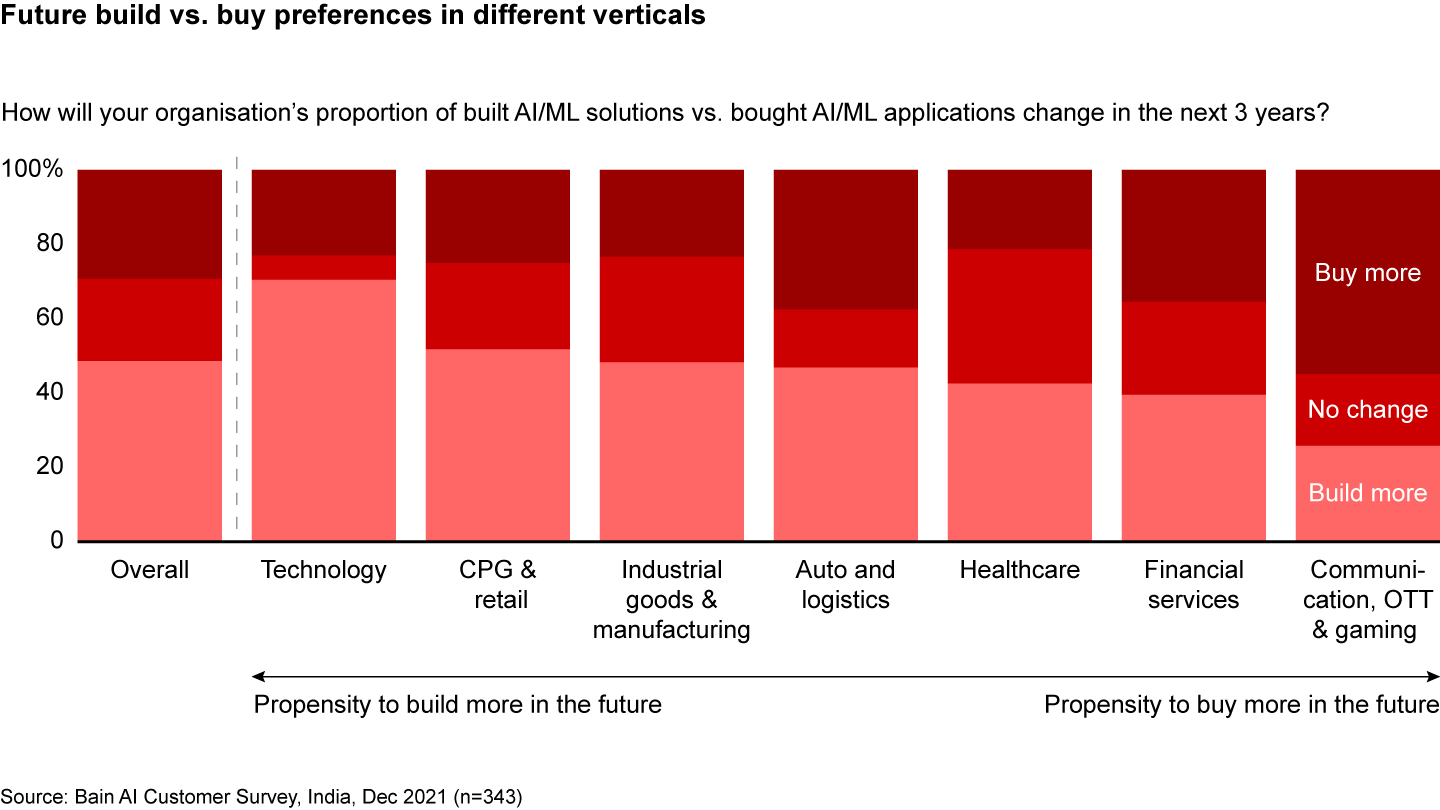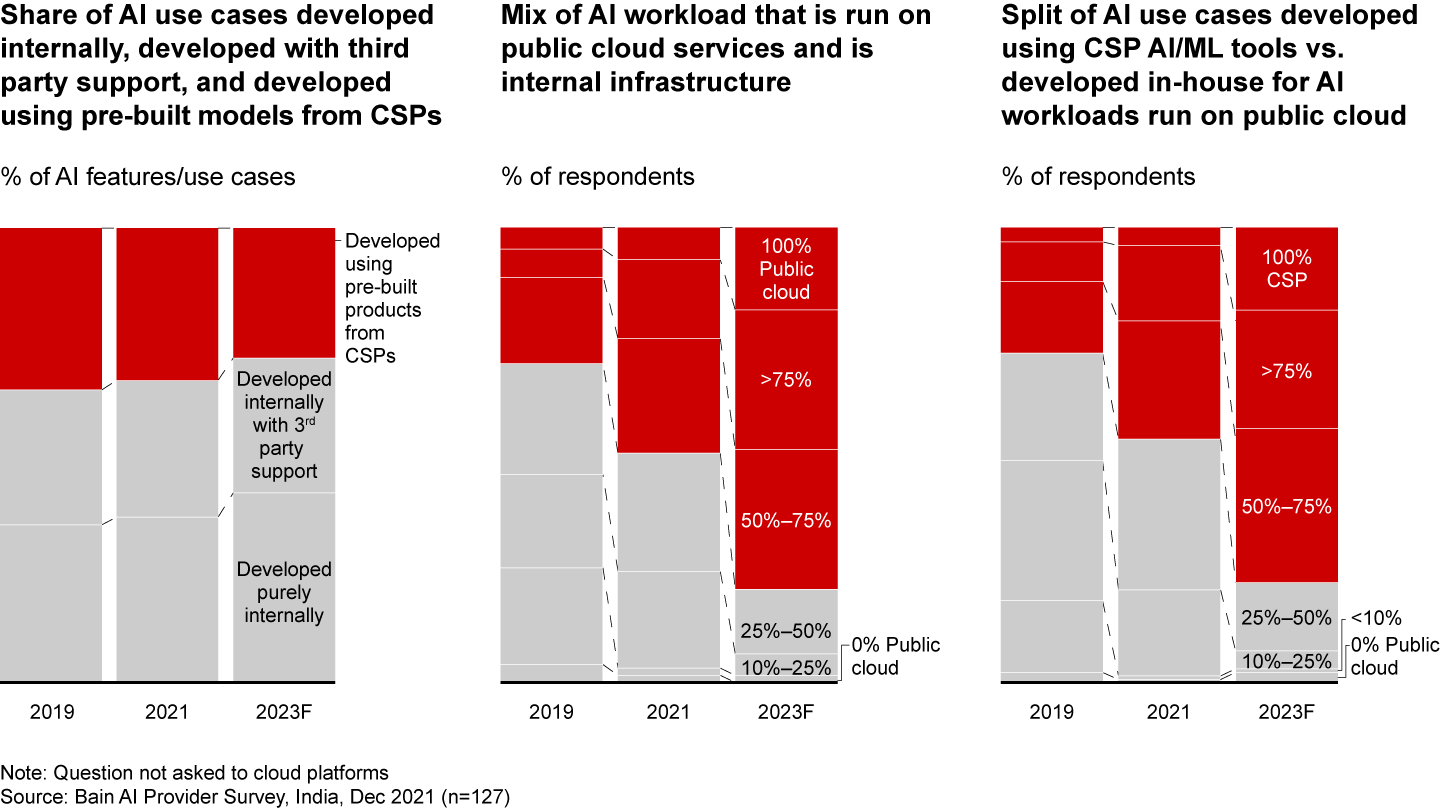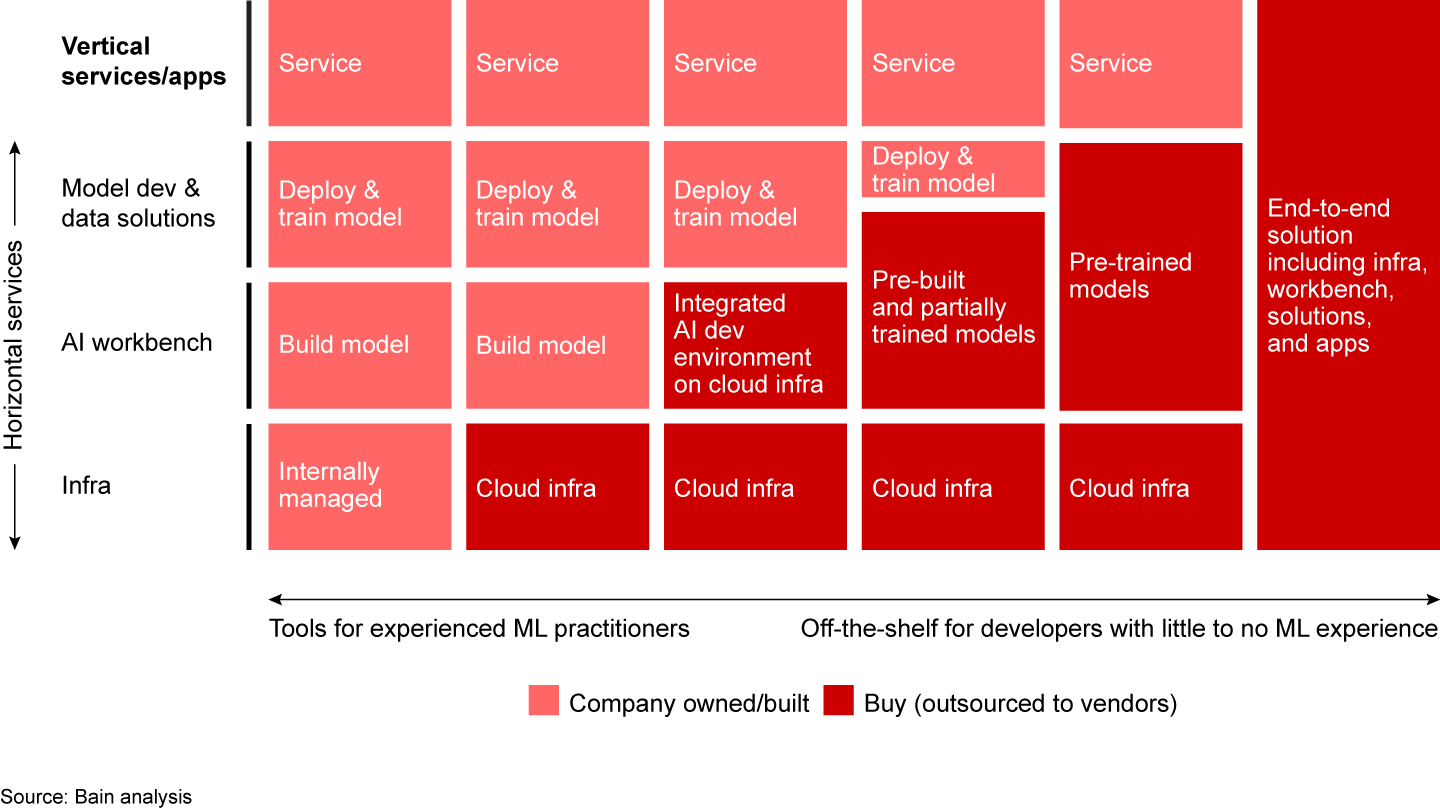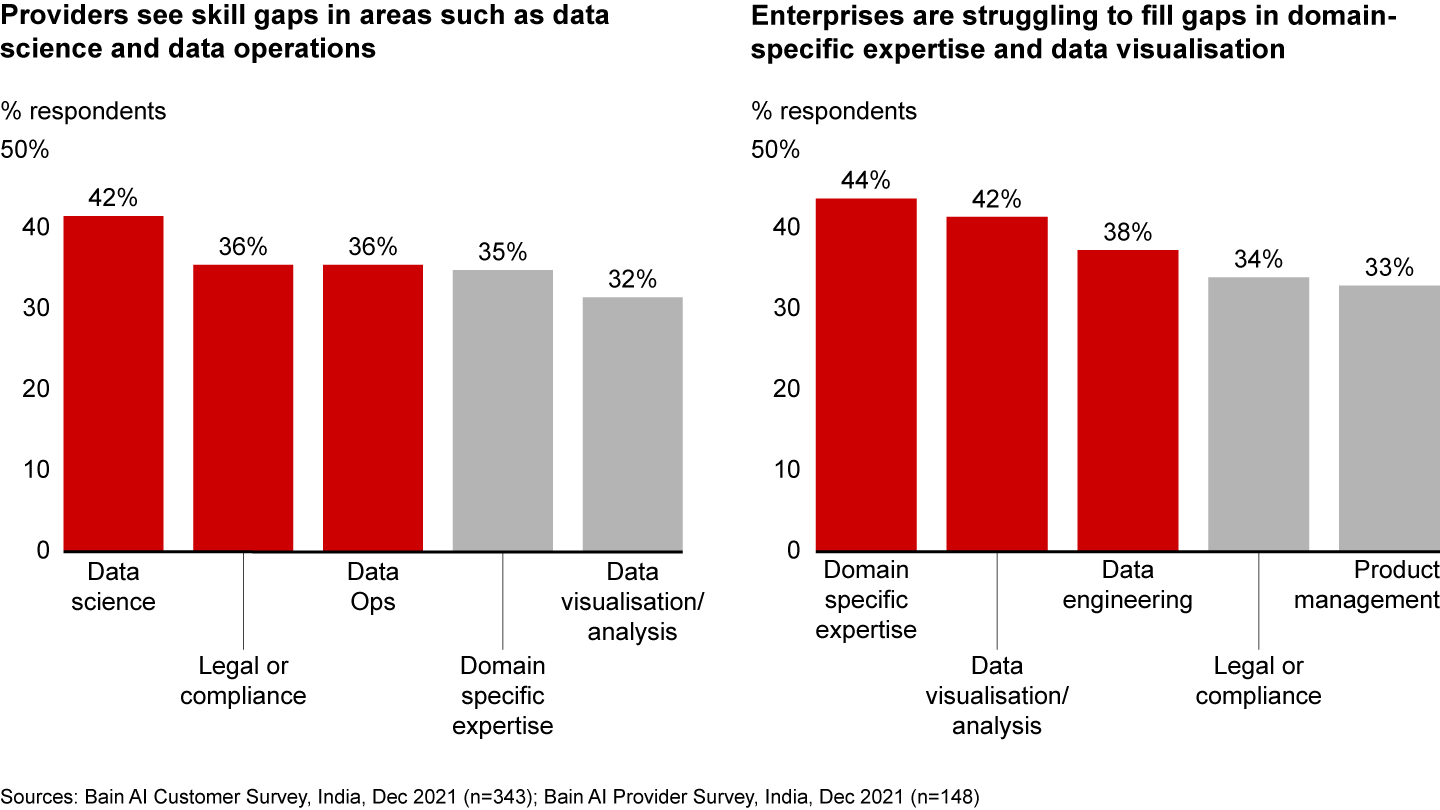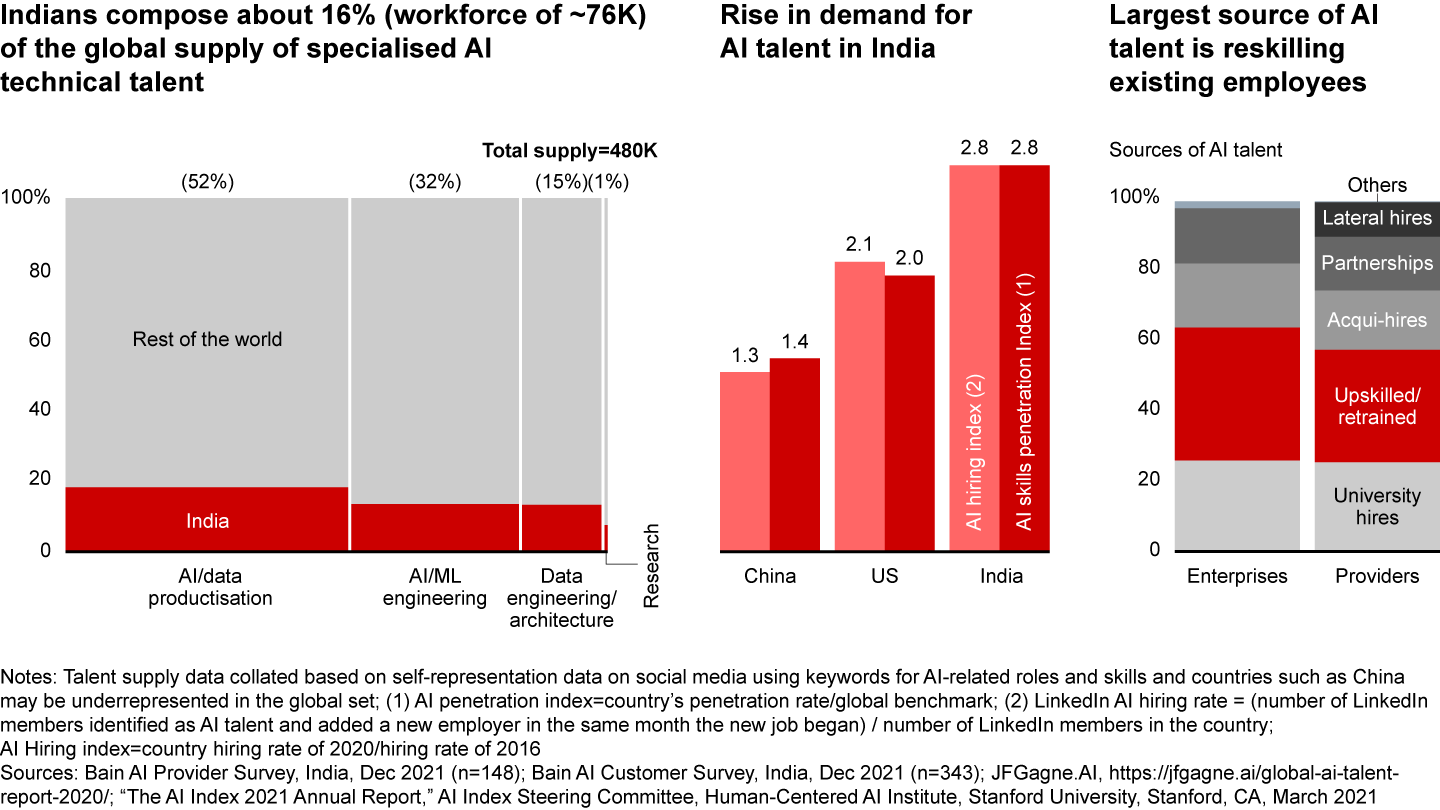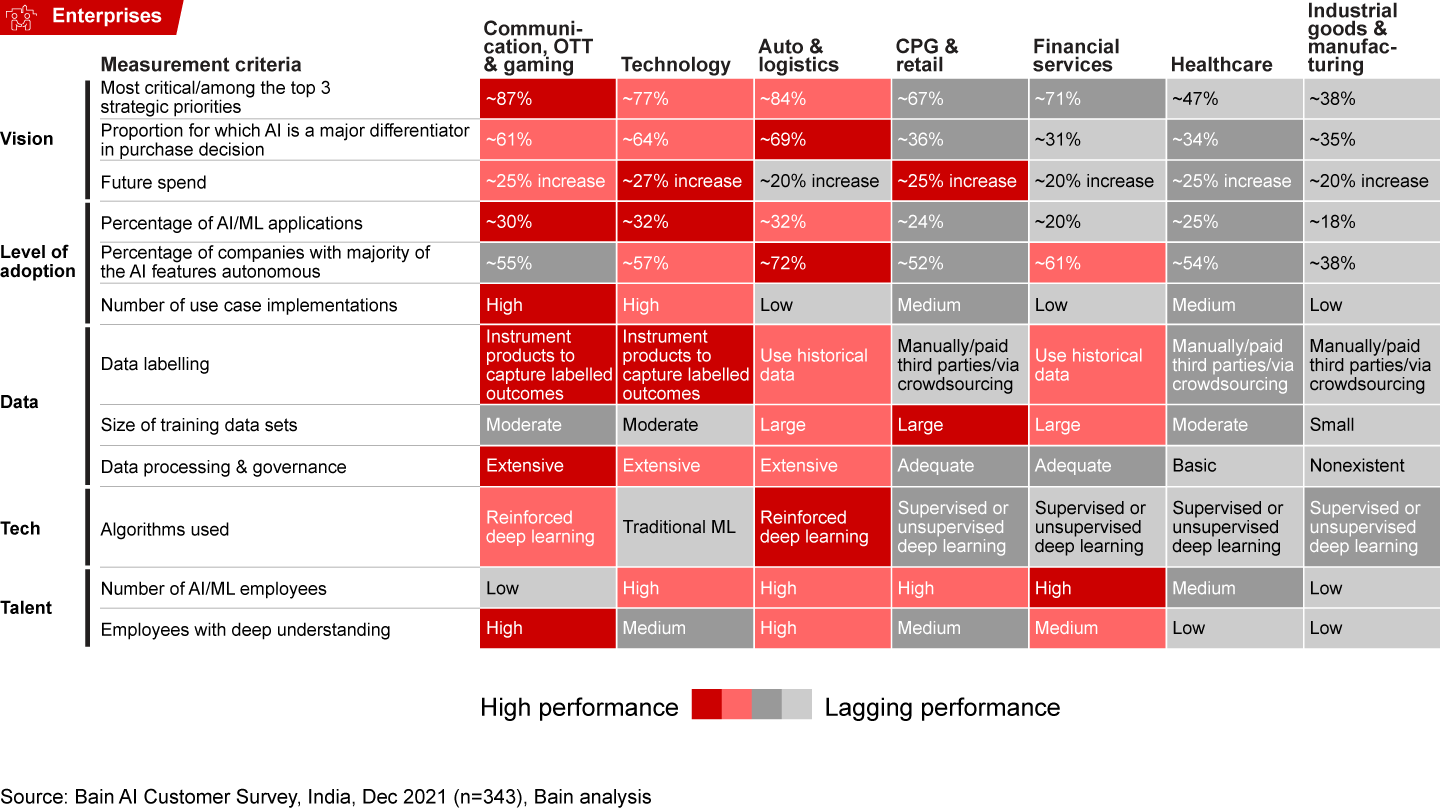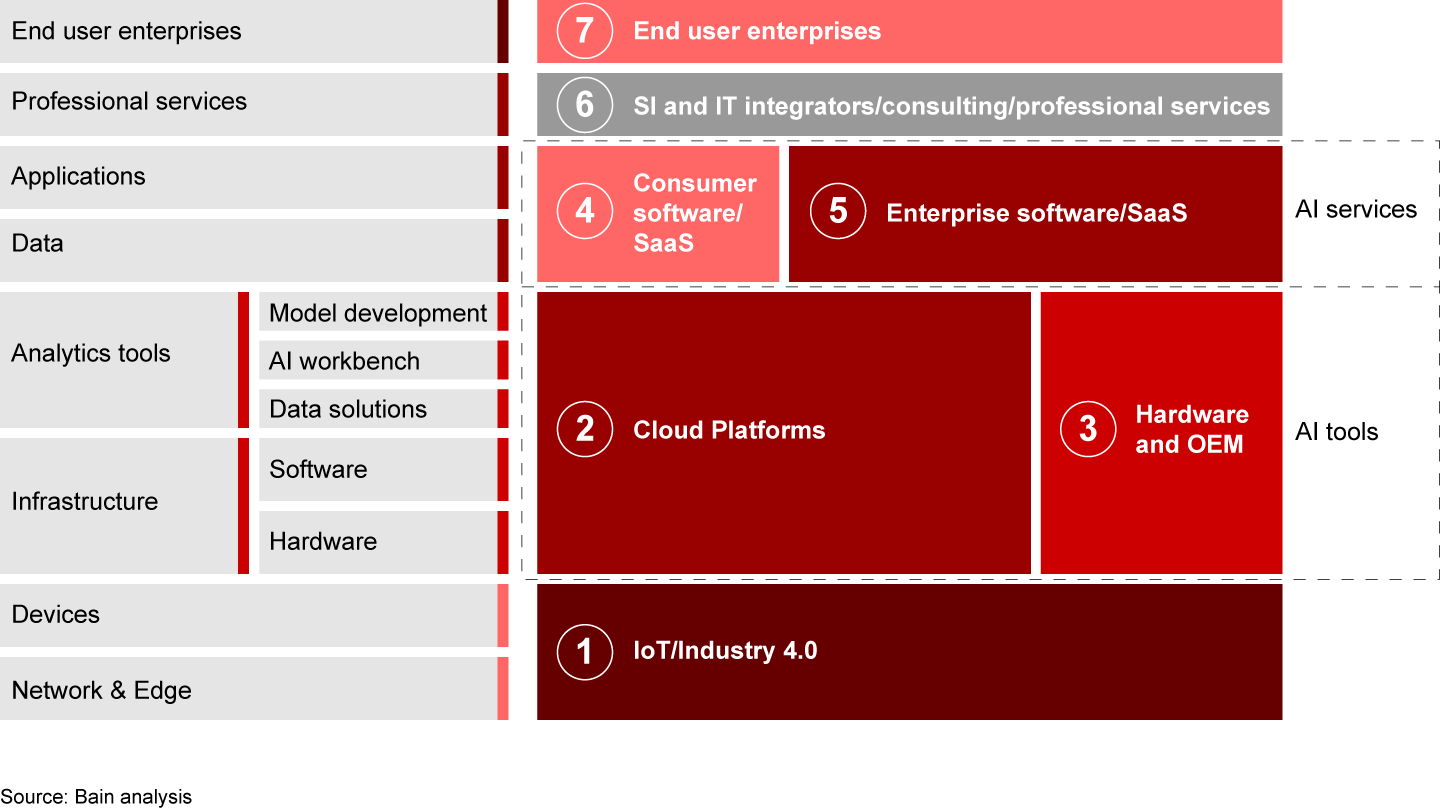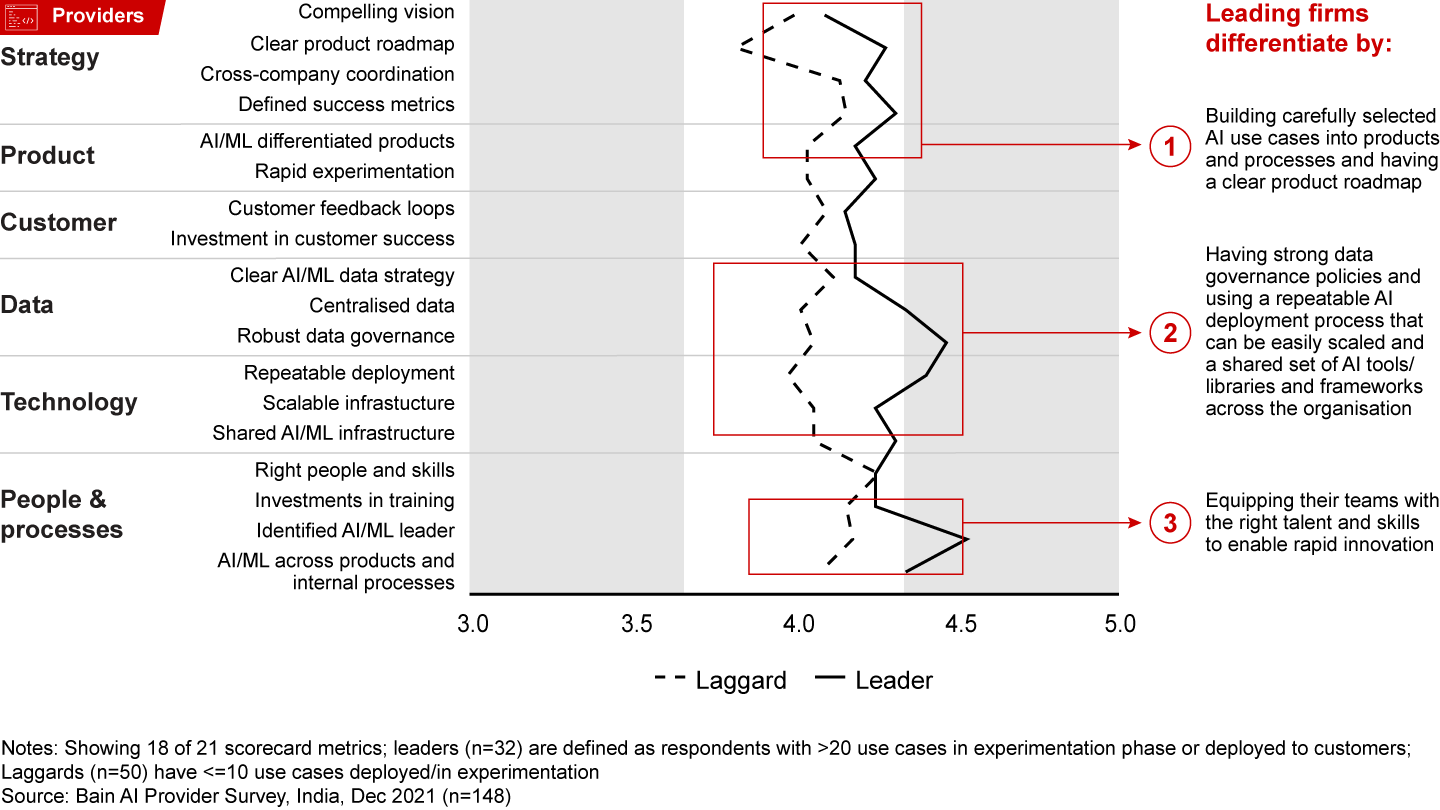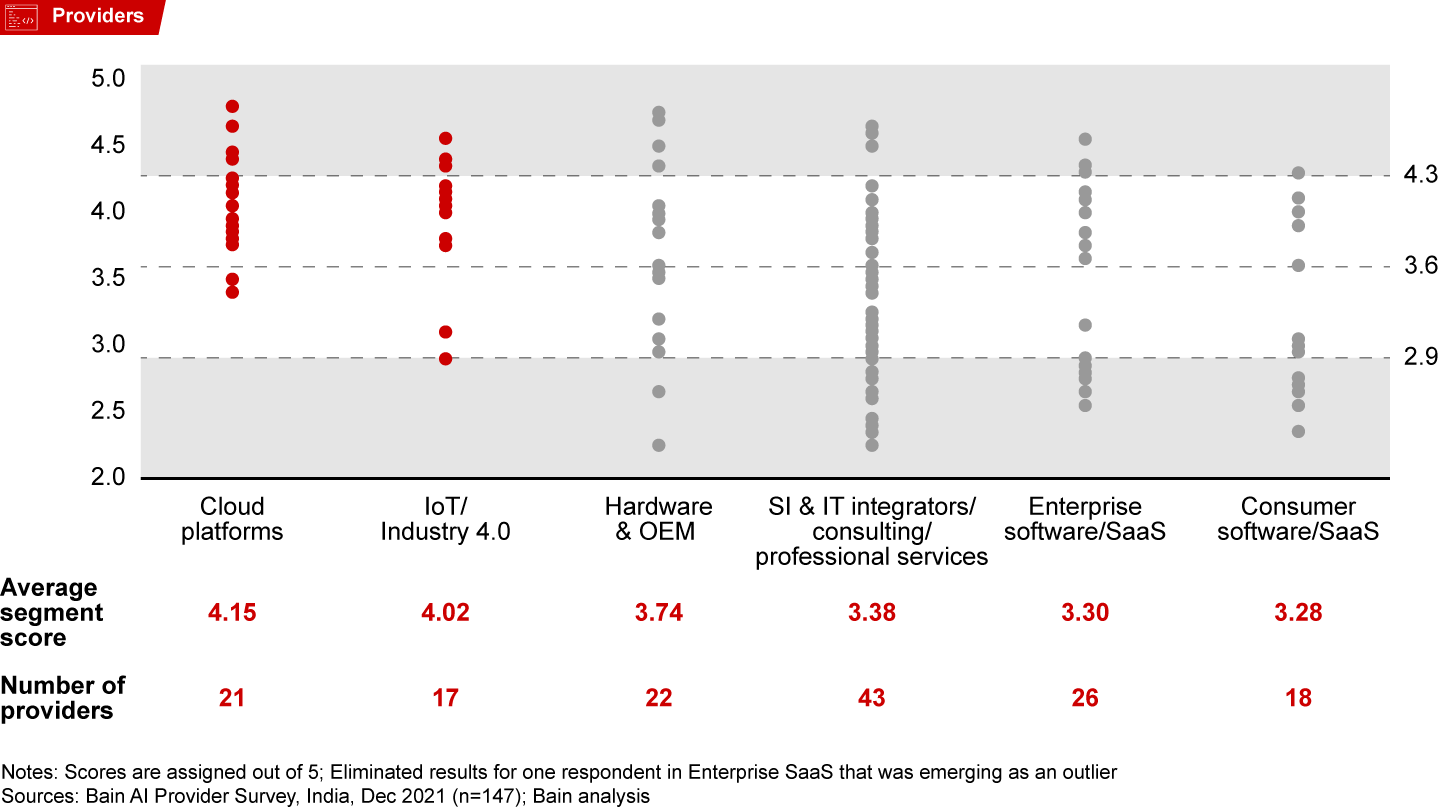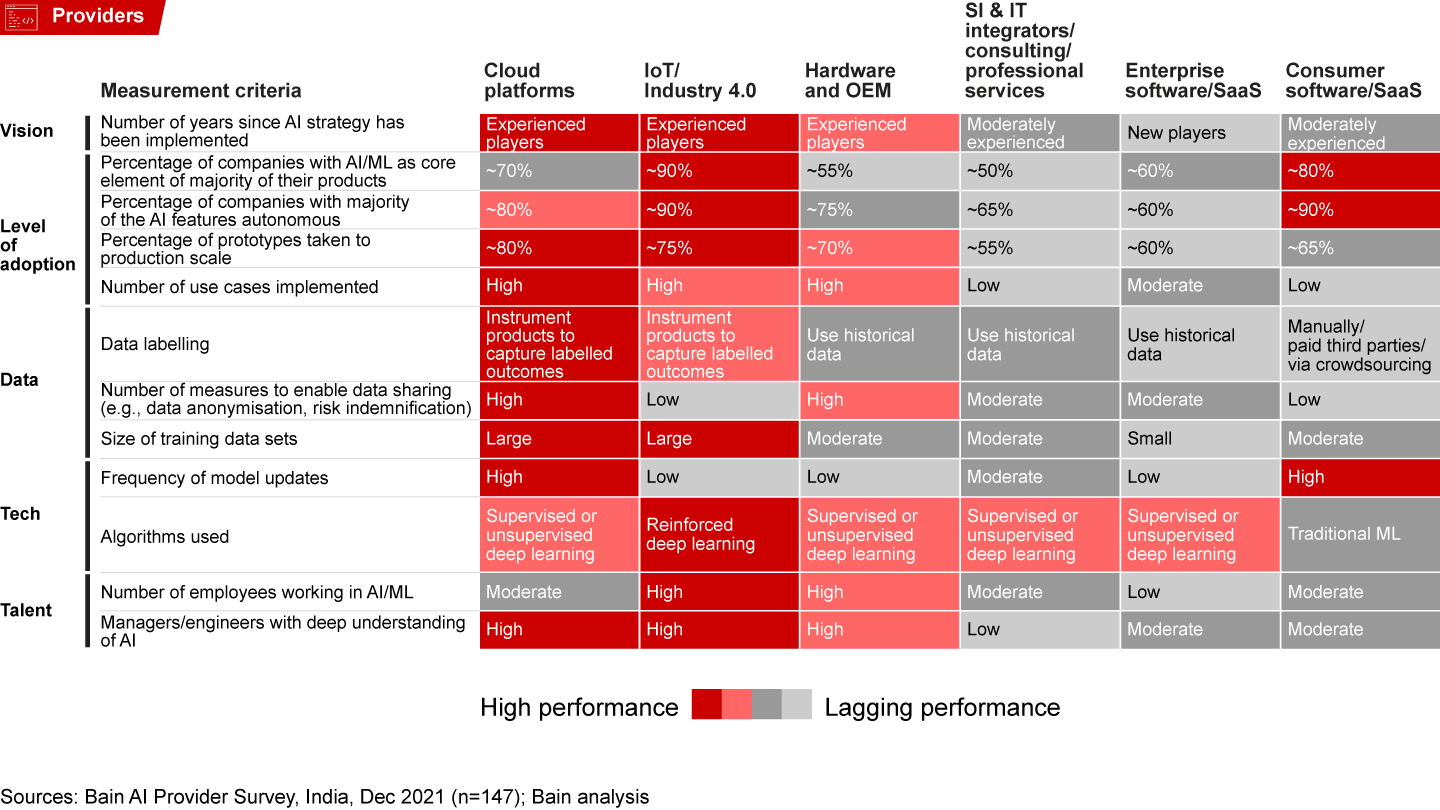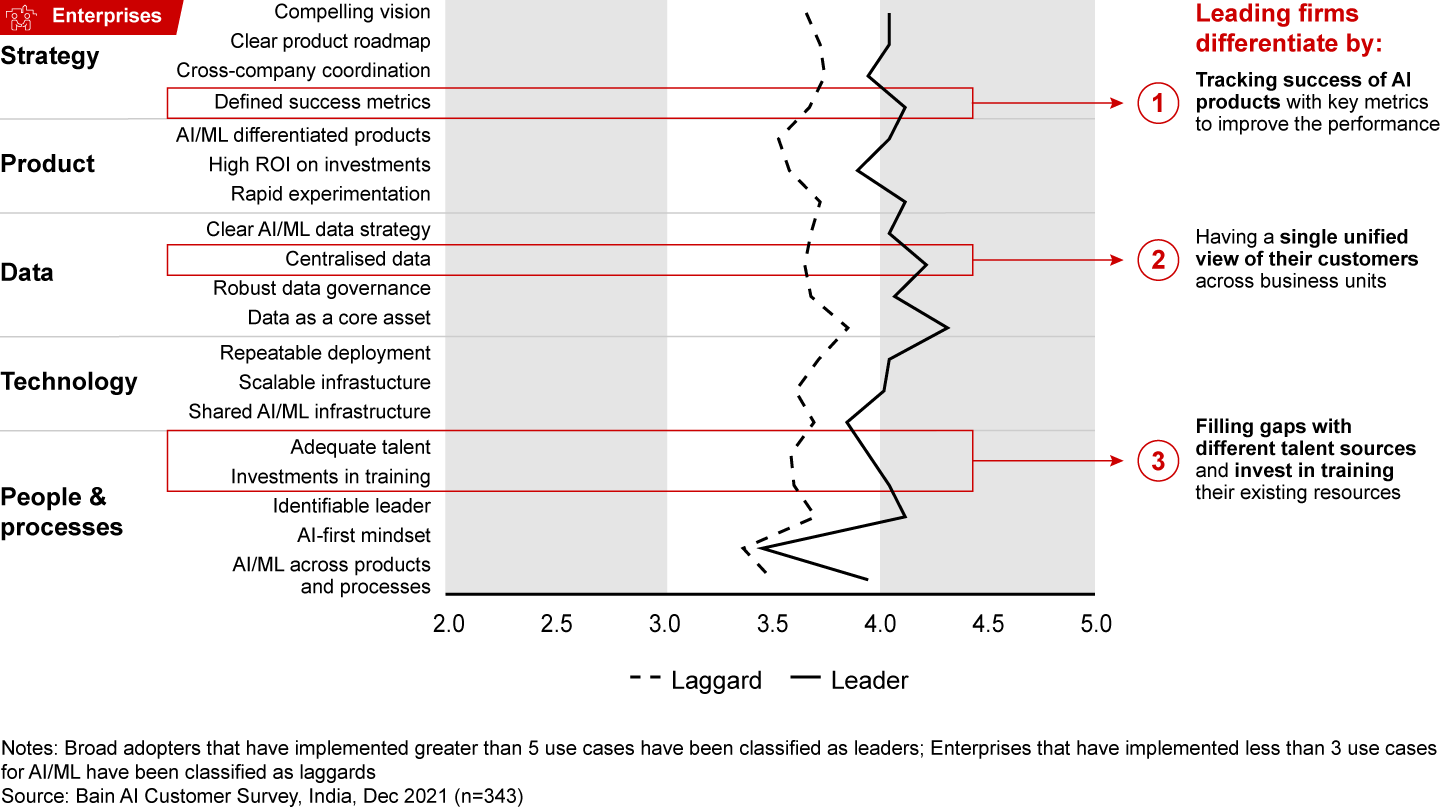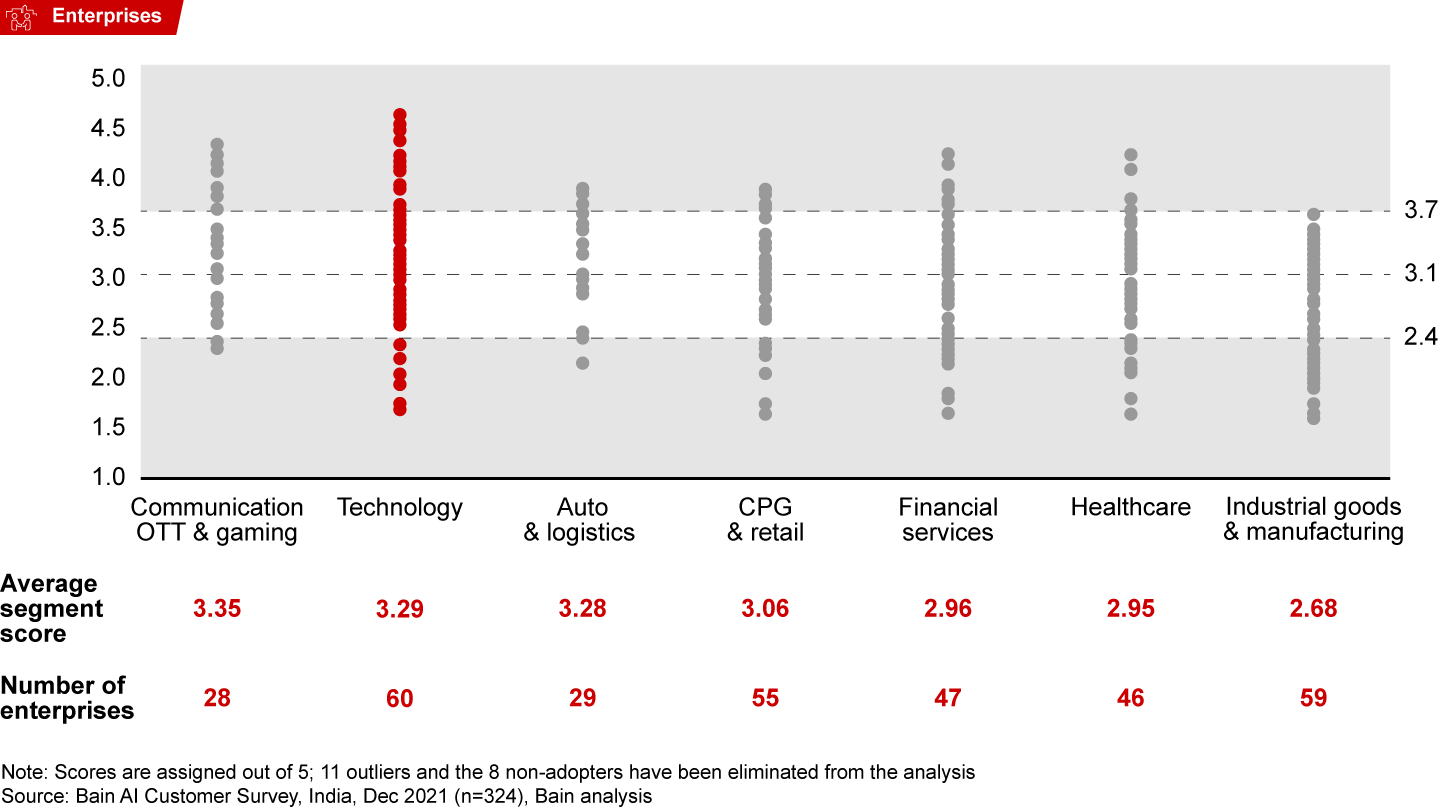Report

Artificial intelligence (AI) is no longer a fringe technology for Indian companies. According to International Data Corporation (IDC), India’s AI market was valued at $3 billion in 2020, which is approximately 1% of the global pie. However, the market is expected to grow at the second-fastest rate of 20% among major economies over the next five years, behind only China. Over the last few years, India has demonstrated rapid adoption of different technologies with rise in penetration of the internet, fintech, e-commerce, edtech, healthtech, and uptick in enterprise investment in cloud and information technology (IT). This has created a foundation of knowledge, data, and infrastructure which can drive value through AI. India is also a global source for talent in data and AI skills; it produces 16% of the world’s AI talent pool, placing it among the top three talent markets.
This report was written in collaboration with Microsoft and IAMAI.

Firms in India have seen a significant uptick in their interest in adopting AI to drive business outcomes. However, there is plenty of hype and hyperbole around what constitutes AI—companies are not shy about making AI claims around systems that are rules-based at best.
In this report, we look at India’s AI landscape from the perspective of enterprises and providers. Enterprises are organisations that have embedded AI or machine learning (ML) into their end products or leveraged it across their internal operations. Providers are technology players that provide building blocks for enterprises to incorporate AI into their systems or products, or companies that offer products and services with AI as a central functionality. This report aims to help enterprises and providers understand how companies are leveraging AI to drive business value and provide a view of high-value AI use cases within their industries. It also provides a framework to help them assess their relative position compared to industry peers on the extent of AI adoption and the relative strength of crucial technology enablers. In the case of providers, the report provides insights on capabilities required to win in the AI market for each provider segment and the buying preferences regarding AI solutions and tools among end user enterprises.
The findings of this report are based on the results of a comprehensive survey completed by 148 providers and 343 enterprises. The survey respondents were C-level executives, senior vice-presidents, vice-presidents, and heads of business units/verticals who are responsible for their company’s decisions related to AI and ML. The enterprises covered were spread across multiple sectors such as financial services, healthcare, consumer packaged goods (CPG) and retail, while for providers we had representation from segments such as cloud platforms, enterprise and consumer software/SaaS players, and system integrators. The target companies included both SMEs and large enterprises headquartered and founded in India, and Indian offices of multinational corporations.
The pervasiveness and interest in AI among Indian enterprises is evidenced by majority of the respondents reporting that they are considering the adoption of AI. Among providers, 64% have AI/ML as a core element in most of their products, while the same is true for 56% of their global counterparts. However, most organisations are still in the early stages of AI adoption, implementing just a few use cases.
The thrust in adoption for enterprises is maximum in sectors such as communication, over-the-top (OTT) and gaming, technology, and financial services, which have seen broad AI adoption (more than three AI/ML models in production at scale) among 40%–55% of organisations.
Providers in India are either ahead of or on par with their global counterparts when it comes to AI capability on scale implementations. Indian providers state that 65% of their prototypes reach production scale—a significant lead over global providers’ 49% success rate. However, there is scope to improve model maturity, such as the use of self-learning/autonomous models enabled by feedback loops (e.g., contextual instead of rule-based chatbots) and managing large data sets.
Providers in India are either ahead of or on par with their global counterparts when it comes to AI capability on scale implementations. Indian providers state that 65% of their prototypes reach production scale—a significant lead over global providers’ 49% success rate.
Among providers, cloud platforms (Microsoft, Amazon Web Services, Google, etc.) are leading through their approach to managing their data, using AI/ML techniques, and scaling their products. Cloud platforms have played a dominant role in the Indian market by offering an end-to-end ecosystem of infrastructure, tools, libraries, and frameworks to encourage experimentation, accelerate development, and enable scaled deployment. The provision of fail-safe mechanisms (e.g., charging solely for production application programming interface calls, shutting off the instance as soon as data processing is done) helps in cost optimisation for platform users. Other providers are increasingly building their solutions with the help of the infrastructure and tools provided by cloud platforms.
“Attribution of value” to AI is challenging for an enterprise given the embedded nature of AI with the software, but 85% of executives from early adopters who have leveraged AI at scale feel it has driven substantial and differentiating value. The level of value added is consistently high, especially among the more mature organisation. Such organisations spend ~0.4%–0.7% of their revenues on AI/ ML and realize an ROI of about 2–4x. In our experience, value addition by AI is not a gradual curve but a binary one. Well-executed AI can significantly differentiate enterprises from their competitors.
Enterprises have realised value from AI investments in two ways: (1) cost optimisation through AI/ ML-enabled automation across multiple verticals (e.g., optimisation of supply chain and logistics and automated diagnostics) and (2) personalisation at scale for end customers (e.g., targeted and personalised marketing and customer experience), predominantly limited to CPG and retail. Adoption of these use cases is expected to broaden as data quality and infrastructure scalability improve.
High adoption of cost optimisation use cases stems from a clear articulation of return on investment (operational cost savings) and progression of use cases (spending analytics, logistics, and forecast optimisation) from advanced analytics to ML. We expect healthcare and CPG and retail to grow fastest in AI/ML spending (~25% year-over-year) with high-value use cases such as drug discovery (healthcare) and targeted personalised marketing (CPG and retail), respectively.
A clear and increasing requirement among Indian enterprises is to ‘build’ for their own customised needs while leveraging the market’s building blocks, tools, and infrastructure. In the next three years, 49% of enterprises plan to increase the proportion of build, compared to 29% that plan to increase the proportion of ‘buy’. A higher preference to increase the proportion of build is seen in industries such as technology (70%), CPG and retail (52%), and industrial goods and manufacturing (48%) fuelled by industry-specific nuances and unique data sets required for AI implementation.
A clear and increasing requirement among Indian enterprises is to ‘build’ for their own customised needs while leveraging the market’s building blocks, tools, and infrastructure.
The need for customisation and integration provides an opportunity for providers to offer professional services for customising models and integrating with existing systems and data for training and deployment. SaaS companies that have traditionally relied on standardised multi-tenant offerings have recognised the sensitivities around data sets and are offering customised AI solutions with bespoke integration.
Compared to large enterprises, small and medium-sized enterprises have predominantly used pre-built models due to their limited ability to build AI in-house. They experiment with easily accessible open-source tools and frameworks for cases they want to develop.
AI leaders differentiate themselves by employing best practices in data management and model development. Currently, data quality, scale infrastructure, and sensitivity/risk emerge as the top barriers for enterprises, hindering greater adoption. On the other hand, providers face constraints in scoping features and developing the minimum viable product (MVP) due to inadequacy in processes, infrastructure, and tools. In terms of talent, providers have observed a lack of skills in data science and data operations. Enterprises report a lack of domain-specific expertise, data analytics, and data engineering. Companies are looking to retrain and upskill their existing employees in AI/ML building blocks to bridge the talent gap.
To characterise enterprises and providers in terms of AI maturity, we created an index to chart their relative strengths across metrics such as level of adoption, deployment of use cases, data management, technology adoption, and talent. Among enterprises, communication, OTT and gaming, technology, and auto logistics fare better than other industries. In contrast, cloud platforms and Internet of Things (IoT) providers emerge ahead of different segments of providers.
Market dynamics: How enterprises adopt AI
- Approximately 80% of enterprises have at least one AI model in production, indicating extensive penetration of AI/ML across enterprises. However, usage of AI across functions and use cases is still low, with only 35% broad adopters (i.e., more than three models in production at scale) among enterprises.
- The extent of broad adoption is prominent in sectors such as communication, OTT and gaming (55%); technology (48%); and financial services (39%). Further, more than 90% of the digital native companies in CPG and retail and financial services have demonstrated AI/ML adoption. Due to the availability of vast amounts of data and the ability to leverage AI to solve problems at scale, adoption in large enterprises is much higher than in smaller enterprises.
- Enterprises that have adopted AI consider improved automation of existing workflows and operational efficiency to be significant sources of value. Leveraging AI for cost optimisation through automation (supply chain optimisation, operations and logistics optimisation, risk management) becomes a key component in auto and logistics, industrial goods and manufacturing, and financial services. As the pandemic has moved the end consumers towards online channels, digital native companies in CPG and retail and financial services are leveraging customer data to their advantage to personalise at scale and optimise their marketing spends.
- Despite increasing AI adoption, a few challenges hinder AI maturity in Indian enterprises. Poor data quality, unsuitable data infrastructure, and sensitivity in sharing data emerge as enterprises’ top barriers for greater adoption.
ROI articulation for customer-facing AI is a challenge—customers pay for the complete experience of the software or product, not just the AI components. Pricing attribution independently for AI remains a challenge.
Market dynamics: How providers approach AI
- Technological solution providers are the drivers of AI adoption in India. There are six segments of providers: cloud platforms, enterprise software/SaaS, consumer software/SaaS, hardware and original equipment manufacturers (OEMs), IoT/Industry 4.0, and system integrators (SIs) and IT integrators/consulting/professional services.
- Providers predominantly focus on leveraging AI to drive information processing (speech, text, image recognition), enhance customer support (in-app recommendations, chatbots, customer interaction coaching), and automate across security, risk management, and infrastructure provisioning. Each segment has demonstrated adoption of different use cases with varying levels of business impact.
- Led by cloud platforms and AI-first SaaS companies, Indian providers are demonstrating an edge over their global counterparts in AI adoption. In India, 64% of providers say that AI is a core element for over half of their product portfolio, compared to 56% of their global counterparts. On average, 65% of the prototypes introduced by Indian providers (49% for global providers) scaled to production. However, there is scope to improve model maturity based on advanced data annotation/labelling techniques and the size of data sets used.
- Cloud platforms demonstrate greater maturity in managing their data, using AI/ML techniques and technologies, and scaling their products. 43% of cloud platforms (and 19% of other providers) continuously update their AI/ML models. 76% of cloud platforms (versus 57% of other providers) specifically instrument their AI products to capture labelled outcomes. More than 80% of the AI/ML features introduced by cloud platforms in India reached production scale and exceeded the expected gains.
- The pre-eminence of the system integrators and professional services market in India enables AI products and solution players to leverage their presence in a range of enterprises to gain new customers and to help enterprises successfully integrate their solutions into the current tech architecture.
While providers in India are doing well in their experimentation with new AI features, some of the attempted innovations do not achieve the planned scale. This is mostly because providers face challenges in scoping the feature and developing the MVP due to inadequacy of development processes.
Build vs. buy: Which way are enterprises and providers leaning?
- The build vs. buy preference for enterprises in AI is not a binary choice. It is relevant for each of the components of the AI stack—infrastructure, workbench tools, data solutions, and AI models. Enterprises that build everything in-house, including their own custom infrastructure, occupy one end of the spectrum, while enterprises that buy end-to-end packaged solutions occupy the other end.
- The proportion of direct plugged-in use cases is lower than global. Recent adopters especially go for options with a lower cost of data transfer, storage, and development. Solutions and the underlying ML models must be customised specifically to customer context and data sets, which drives the preference to build.
- In the next three years, half of enterprises plan to increase the proportion of build, compared to 29% that plan to increase the proportion of buy, with a higher preference to increase the proportion of build seen in industries such as technology (70%), CPG and retail (52%), and industrial goods and manufacturing (48%).
- While small enterprises prefer to buy pre-built models (45%) due to the high cost of building in-house, they also experiment with easily accessible open-source tools and frameworks for cases they want to develop. Digital native companies have shown a similar trend.
- Providers, too, are inclined towards building their models using third-party support or open-source tools/services. Their reliance on cloud platforms for pre-built models and packaged solutions is expected to decrease in the coming years (from 36% of the AI features/use cases in 2019 to a projected 29% in 2023).
- While Indian enterprises are keen to build their AI/ML models in-house, they exhibit a preference to buy the commoditised cloud infrastructure and AI work benches, which helps them to experiment at will on an elastic compute-storage enablement. Cloud platforms have played a dominant role in increasing the preference to build by offering an end-to-end ecosystem of infrastructure, tools, libraries, and frameworks to encourage experimentation, accelerate development, and ensure scaled deployment. Provision of fail-safe mechanisms provides cost optimisation for enterprises looking to experiment and build AI on their own using cloud infrastructure and tools.
- The migration of workloads from on-premise to cloud has further increased the usage of cloud platform tools and infrastructure. Among non-cloud platform providers, 80% are expected to shift to the public cloud for running their AI workload in 2023, compared to 30% in 2019. Use of cloud platforms vs. in-house tools will increase from 28% in 2019 to 78% in 2023 for AI workload on the public cloud.
Based on the level of adoption and the build vs. buy preferences, Indian enterprises can be characterised into four major segments: (1) ‘Innovators’ that are broad adopters and have a high preference to build custom models internally, (2) ‘Traditionalists’ that are broad adopters looking to implement AI across the organisation but burdened by legacy infrastructure and data quality issues, (3) ‘Opportunists’ that are looking to implement AI for only high-value use cases and would prefer easy-to-integrate and easy-to-use tools, and (4) ‘Experimenters’ that are about to start on their AI implementation journey and are looking for ecosystem support and solutions that can be integrated seamlessly. Providers can shape their strategies according to the segment they wish to target.
Data and technology: Key enablers for AI success
- While the availability of data and cloud-based infrastructure have aided AI adoption, concerns related to data security, infrastructure, and management continue to be the most significant barriers for enterprises. 53% of enterprises do not have a unified view of their customers. Only 45% of enterprises that build AI solutions specifically instrument their products to capture labelled outcomes. Providers fare slightly better in this regard.
Among enterprises and providers that have succeeded in their AI endeavours, the leaders have differentiated themselves by following certain best practices regarding data management and use of different techniques and technologies. Some of these common best practices include instrumenting products to capture labelled outcomes; using failure injection during testing, online learning, model monitoring, graceful degradation of models in production; and having a centralised repository of ML models with documentation.
Figures 8-11: Figure 12
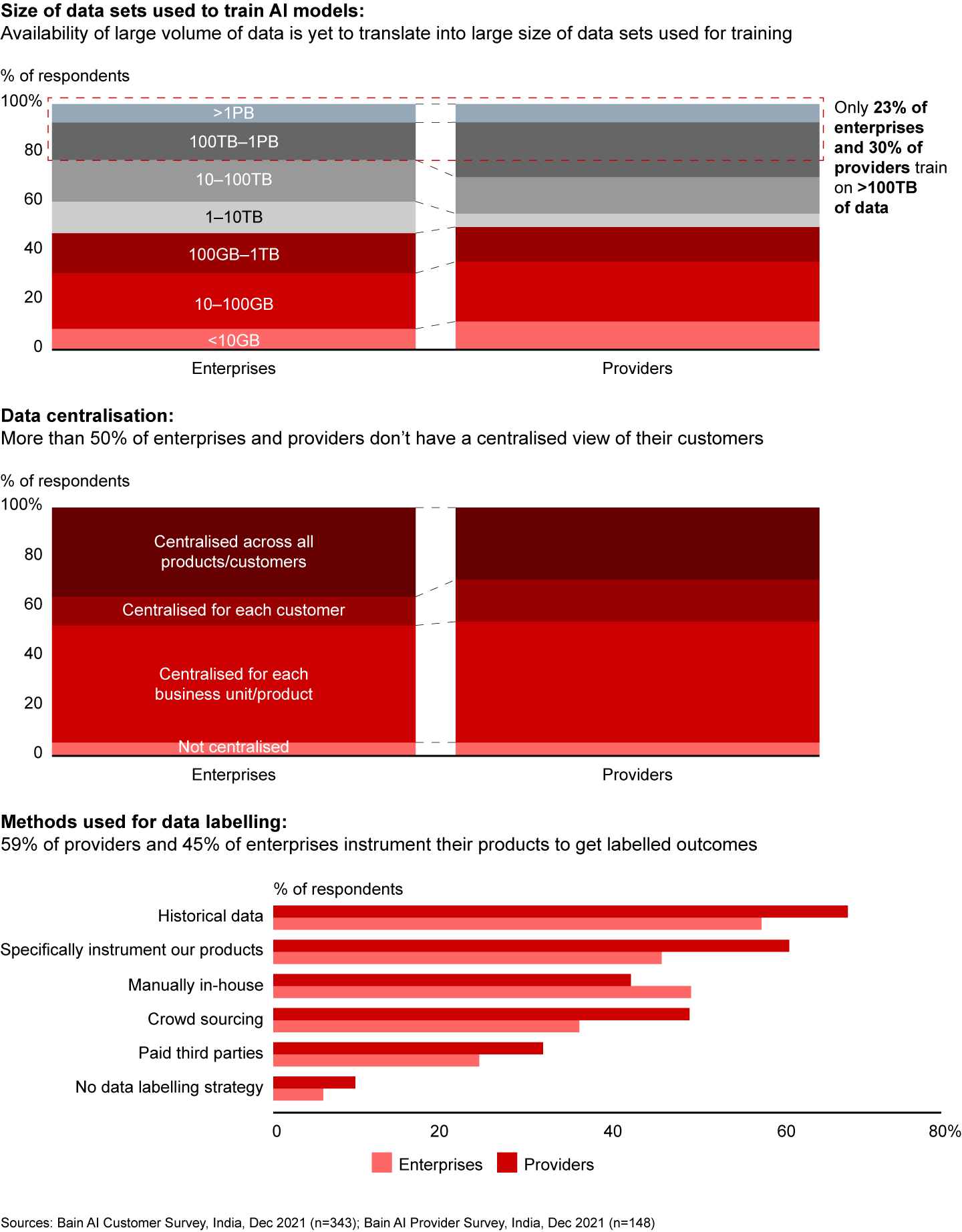
Talent: Key enablers for AI success
- Although India constitutes a small share of the global AI market, it produces 16% of global AI talent, placing it among the top three contributors in the world. With a legacy of exporting tech talent globally, India produces more talent than it consumes. India’s technology workforce grew up in an internet/cloud-first world. Its ability to assemble solutions from combinations of legacy, cloud, and SaaS components is world-class.
- Micro, small and medium enterprises (MSMEs), focused on addressing niche industry-specific opportunities, are innovating far above their weight by leveraging their workforce and specialist contractors to incorporate AI/ML modules into their e-commerce ventures and digital business processes. Similarly, there has been a spike in demand from large conglomerates wanting to transform their operations with AI/ML, spurred on by the pandemic. An analysis of AI-related employment trends on LinkedIn in 2020 showed that India is leading the way in AI skills penetration across occupations, and there has been a significant uptick in AI-related hiring.
- The willingness of managers to experiment has led to a war for AI talent, which is still relatively scarce in relation to the demand. Skill gaps are most widely observed for providers in data science, data operations, and legal/compliance areas. On the other hand, enterprises lack domain-specific expertise, data visualisation/analysis talent, and data engineers. Much of the talent today exists in AI application development due to avenues available for upskilling, retraining, self-learning, and experimenting with open-source tools.
- To systematically build AI talent for enterprise demand, support from academic institutions is needed to introduce comprehensive formal education in core AI technology. Steps have been taken to this effect with the establishment of National Education Policy 2020, which includes provisions to include AI in each stage of education and has directed universities to work towards offering masters and doctoral programmes in this field.
- The talent equation in India in terms of quantity will only get better, but a clear distinction will emerge between the data engineers, data scientists, and product managers. Cloud platforms and providers with better quality data scientists and product managers will be better placed to lead in the market.
Key battlegrounds: How to win
- The Indian AI market can be segmented into seven major segments or battlegrounds: end user enterprises, cloud platforms, enterprises software/SaaS providers, consumer software/SaaS providers, hardware providers and OEMs, IoT/Industry 4.0 providers, and SI and IT integrators/consulting/professional service providers.
- The extent of AI maturity and the ability to leverage AI for each of these significant battlegrounds was assessed through an AI index, which was calculated for each segment’s basis factors, such as level of adoption, deployment of use cases, and strength in the three critical capabilities required for AI implementation: data, technology, and talent.
- Communication, OTT and gaming, technology, and auto and logistics have fared well. In addition to having some of the highest proportions of adopters, communication and OTT and gaming organisations have also implemented AI across the most significant number of use cases compared to other industries. Auto and logistics organisations have demonstrated relative strength in critical data, technology, and talent capabilities.
- Industrial goods and manufacturing and healthcare lag most other industries. The healthcare sector is hampered with respect to data processing and governance technologies.
- On the provider side, cloud platforms and IoT providers emerge ahead of other segments on the AI index. While IoT providers invest in hiring the right talent, cloud platforms have demonstrated greater maturity by deploying complex deep learning algorithms, continuously updating their models, and adopting practices for customers to securely share their data.
- We find SaaS companies need to improve their data strategy. SIs and IT consulting companies have the scope to deploy more number of use cases and increase the share of AI talent in senior/managerial positions.
- The AI index is a diagnostic tool that gives an overview of strengths and areas of improvement in each segment or vertical. The business and function leaders from each major battleground and enterprise can take the diagnostic results into account to adopt some measures and practices that increase the likelihood of success in introducing and implementing new AI features.
Figures 15-21: Figure 22
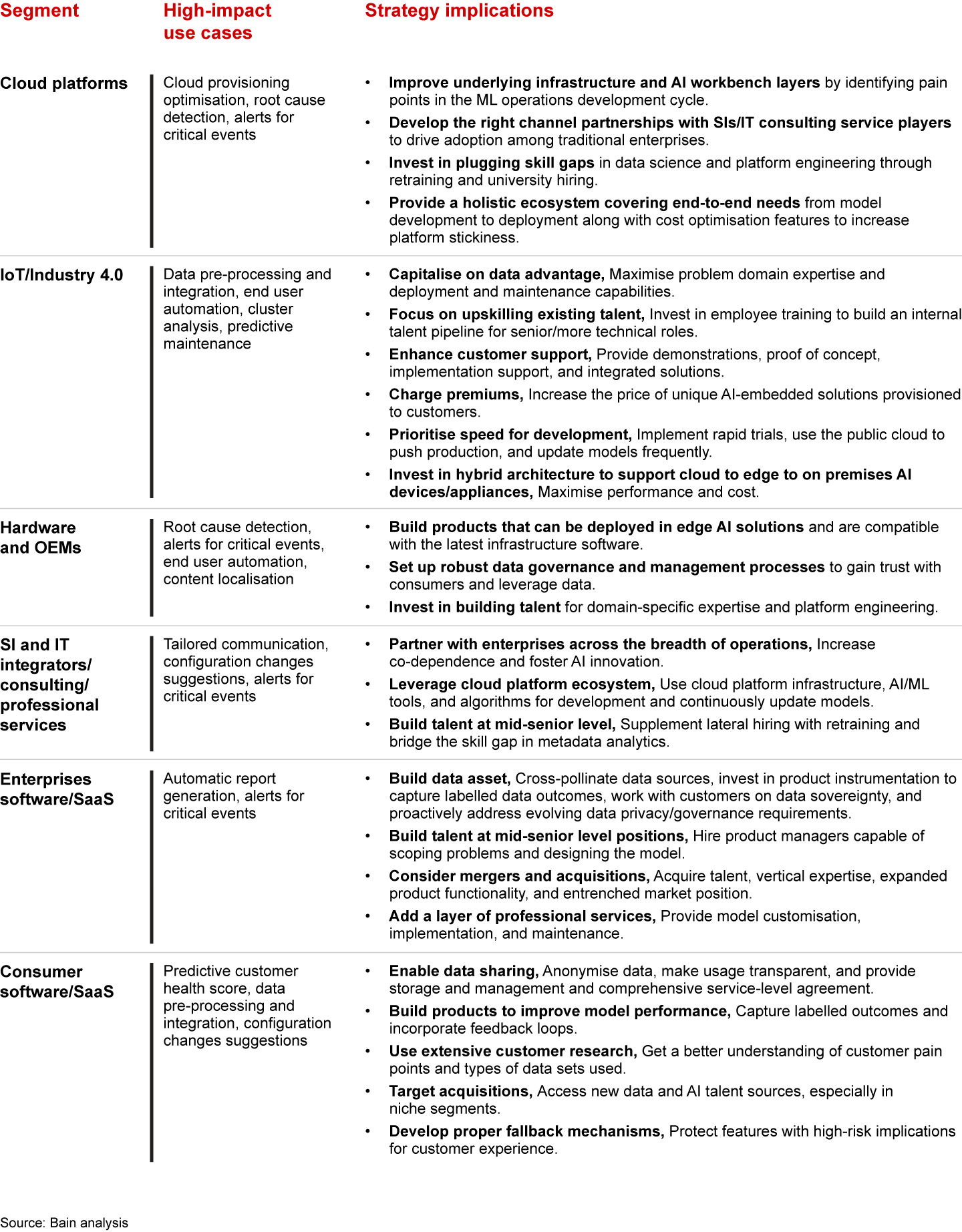
Figures 15-21: Figure 23
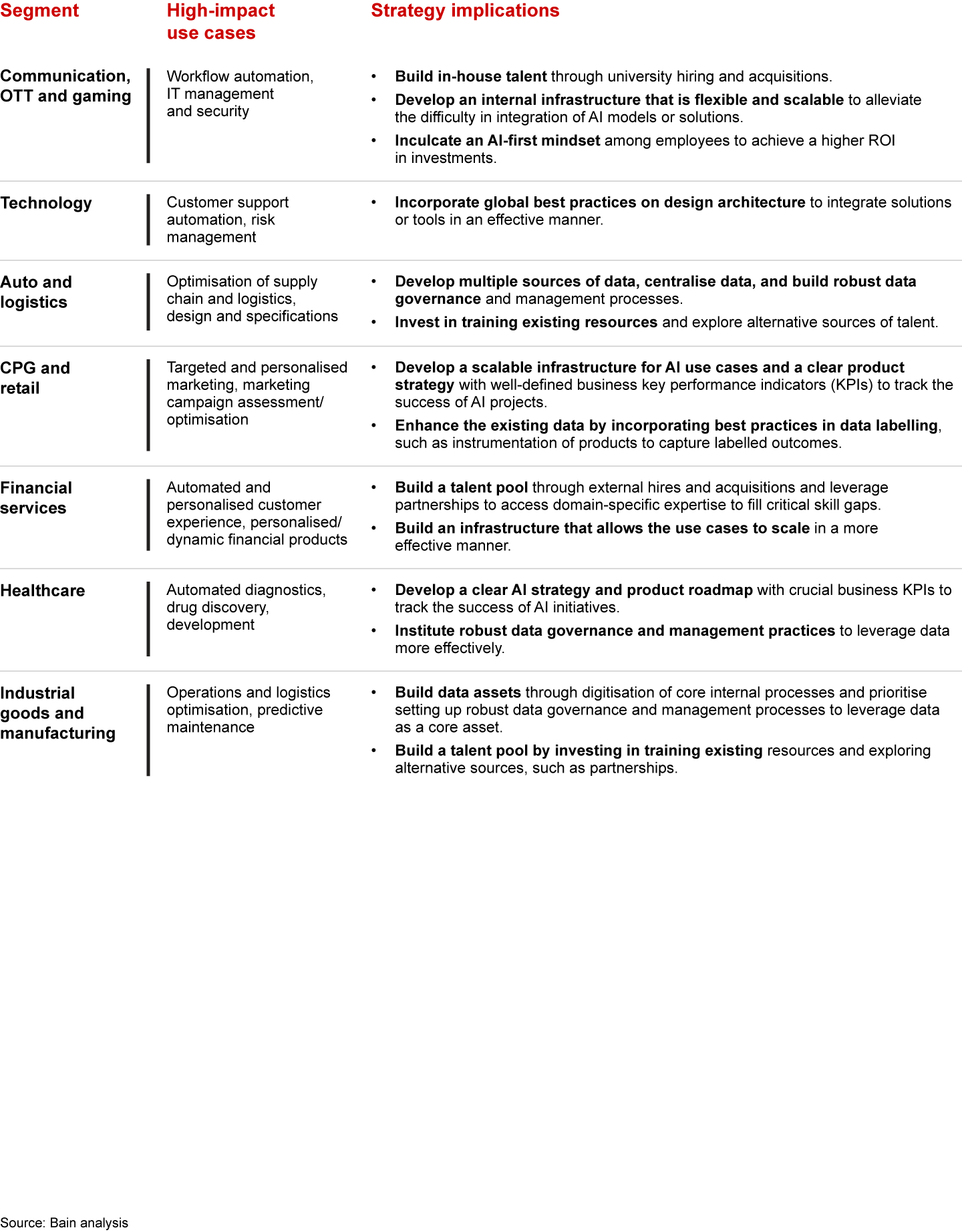

About Microsoft
Microsoft (Nasdaq “MSFT” @microsoft) enables digital transformation for the era of an intelligent cloud and an intelligent edge. Its mission is to empower every person and every organisation on the planet to achieve more. Microsoft set up its India operations in 1990. Today, Microsoft entities in India have over 18,000 employees, engaged in sales and marketing, research, development, and customer services and support, across 11 Indian cities—Ahmedabad, Bengaluru, Chennai, New Delhi, Gurugram, Hyderabad, Kochi, Kolkata, Mumbai, Noida, and Pune. Microsoft offers its global cloud services from local data centers to accelerate digital transformation across Indian start-ups, businesses, and government organisations.

About the Internet & Mobile Association of India
Established in 2004, the Internet & Mobile Association of India (IAMAI) is a not-for-profit industry body and the country’s only organisation representing the digital services industry with over 400 Indian and multinational corporations as its members, which include established companies in diverse sectors of the digital ecosystem as well as start-ups. Its mandate is to expand and enhance the online and mobile value-added services sectors. It is dedicated to presenting a unified voice of the businesses it represents to the government, investors, consumers, and other stakeholders. IAMAI represents varied sectors, such as digital advertising, digital entertainment, traveltech, online gaming, digital payments, fintech, digital commerce, edtech, healthtech, agritech, blockchain, big data, ML, AI & IoT, AR/ VR, and logisticstech to name a few.
